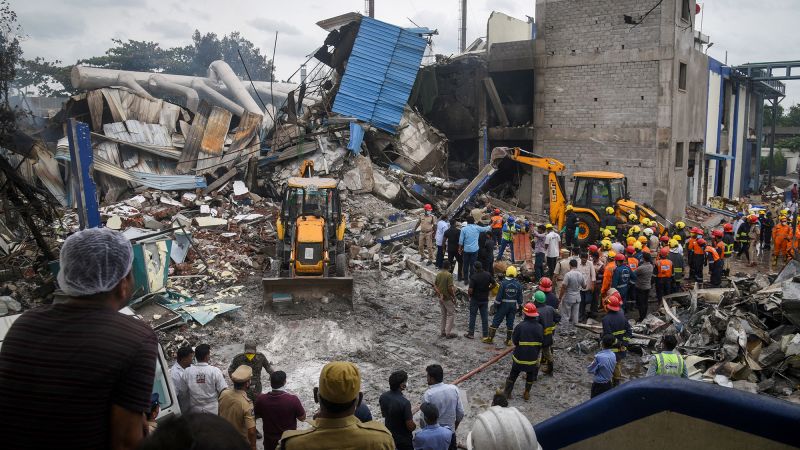The death toll from the devastating explosion and fire at Sigachi Industries’ chemical factory in southern India has climbed to at least 39, officials confirmed on Tuesday. The tragedy has forced the pharmaceutical supplier to halt operations for 90 days. Located in the state of Telangana, the factory’s disaster has prompted the state government to form a five-member committee to investigate the incident. The cause of the explosion remains undisclosed by the company.
The explosion, which occurred on Monday, also left 34 individuals injured. According to GV Narayana Rao, director of the Telangana fire disaster response service, the building completely collapsed. “We are still clearing the debris,” Rao told Reuters, emphasizing that a full assessment of the situation would only be possible once the debris is entirely cleared. “Only then will we be able to assess if any other body is still remaining under the debris or if it is all clear,” he added.
Immediate Impact and Response
Police officials reported that over 140 people were working in the plant at the time of the incident. District administrative official P. Pravinya noted that 25 of the deceased have yet to be identified. Chandan Gound, a 32-year-old worker at the factory, recounted his harrowing escape. “I came out to use the restroom and heard a loud blast. It sounded like a bomb blast. I saw fire and a part of it spread towards me. I jumped the wall and escaped,” Gound told Reuters by phone. He added that while many managed to escape, a significant number were trapped inside.
Sigachi Industries, known for producing microcrystalline cellulose (MCC), serves clients in the pharmaceutical, food, cosmetic, and specialty chemicals sectors across various countries, including the US and Australia. MCC’s properties make it a crucial ingredient in pharmaceutical manufacturing, as well as in food and cosmetic products.
Economic and Operational Consequences
The Telangana plant contributes over a quarter of Sigachi’s total production capacity of 21,700 million metric tons per annum. Following the incident, Sigachi’s shares plummeted by about 8% on Tuesday, marking their sharpest two-day decline on record. The company has cited damage to equipment and structures as reasons for the 90-day operational halt and has initiated insurance claims for the fully insured plant.
This incident adds to a series of industrial accidents in India, highlighting ongoing safety challenges in the manufacturing sector. In a separate event on Tuesday, a massive fire at a crackers factory in the Sivakasi manufacturing cluster in Tamil Nadu resulted in five deaths and four injuries, according to a fire department official.
Historical Context and Industry Challenges
Industrial accidents in India have been a recurring issue, often attributed to lax safety standards and inadequate enforcement of regulations. The country has witnessed several high-profile incidents in recent years, prompting calls for stricter safety protocols and better emergency response mechanisms. The Sigachi incident underscores the urgent need for reforms in the sector to prevent future tragedies.
Experts in industrial safety have long advocated for comprehensive safety audits and the implementation of advanced safety technologies to mitigate risks. The pharmaceutical and chemical industries, in particular, require stringent oversight due to the hazardous nature of their operations.
Looking Ahead: Implications and Reforms
The Telangana government’s decision to form an investigative committee reflects a commitment to uncovering the root causes of the incident and preventing similar occurrences. The findings of this investigation could lead to significant policy changes and improvements in safety standards across the industry.
As the affected families and communities begin the long process of recovery, there is a collective call for accountability and reform. The tragedy at Sigachi Industries serves as a stark reminder of the human cost of industrial negligence and the urgent need for systemic change.
In the coming months, industry stakeholders, policymakers, and safety experts will likely engage in discussions aimed at enhancing safety protocols and ensuring that such incidents become a thing of the past. The lessons learned from this tragedy could pave the way for a safer and more responsible industrial landscape in India.
About The Author
 Katy Perry’s Concert Drama: Trapped in Metal Sphere Mid-Performance
Katy Perry’s Concert Drama: Trapped in Metal Sphere Mid-Performance Judge Clarifies Drug Distribution in Diddy Trial Amid Jury Deliberations
Judge Clarifies Drug Distribution in Diddy Trial Amid Jury Deliberations Travis Kelce on Life with Taylor Swift: Fame’s Unexpected Challenges
Travis Kelce on Life with Taylor Swift: Fame’s Unexpected Challenges Lady Gaga and Elton John Rumored to Skip Jeff Bezos’ Lavish Wedding
Lady Gaga and Elton John Rumored to Skip Jeff Bezos’ Lavish Wedding Teenage Mutant Ninja Turtles Expands Universe with New Comic Spinoff
Teenage Mutant Ninja Turtles Expands Universe with New Comic Spinoff